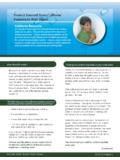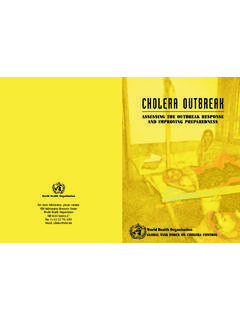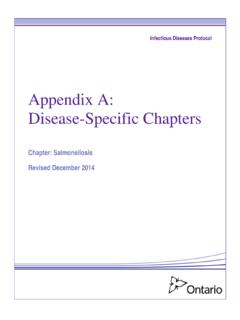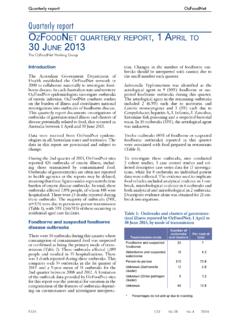Transcription of Outbreak Investigations: The 10-Step Approach
1 Outbreak Investigations: The 10-Step ApproachZack Moore, MD, MPHM edical EpidemiologistNorth Carolina Division of Public HealthLearning Objectives1. List three reasons why Outbreak investigations are important to public health2. Know the steps of an Outbreak investigation3. Give an example of a single overriding communication objective (SOCO) Reasons to investigate an Outbreak Identify the source (and eliminate it) Develop strategies to prevent future outbreaks Evaluate existing prevention strategies Describe new diseases and learn more about known diseases Address public concern It s your job!
2 When to InvestigateConsider the following factors: Severity of illness Transmissibility Unanswered questions Ongoing illness/exposure Public concernEnvironmental Investigation Vital part of investigation Should be done with (not instead of) epidemiologic investigationCollecting and Testing Environmental Samples Ideally, epidemiologic results guide sample collection Often collected at the same time Can support epidemiologic findings Positive or negative results can be misleadingPrinciples of Outbreak Investigations Be systematic!
3 Follow the same steps for every type of Outbreak Write down case definitions Ask the same questions of everybody Stop often to re-assess what you know Line list and epi curve provide valuable information; many investigations never go past this point Coordinate with partners ( , environmental and epidemiology)10 Steps of an Outbreak Investigation1. Identify investigation team and resources2. Establish existence of an outbreak3. Verify the diagnosis4. Construct case definition 5. Find cases systematically and develop line listing6.
4 Perform descriptive epidemiology/develop hypotheses7. Evaluate hypotheses/perform additional studies as necessary8. Implement control measures9. Communicate findings10. Maintain surveillance10 Steps of an Outbreak Investigation1. Identify investigation team and resourcesInvestigation Resources Local Epi teams State CD Branch epidemiologists / subject matter experts Nurse Consultants PHRST teams Disease Investigation Specialists (DIS) Other Team Epi-Aid (UNC) CDC10 Steps of an Outbreak Investigation1.
5 Identify investigation team and resources2. Establish existence of an outbreakWhat is an Outbreak ?Increase in cases above what is expected in that population in that area Four kids with cough and runny nose in a child care center in January? Woman vomiting after eating at Restaurant A? 10 members of the swim team vomiting after eating at Restaurant A? One case of smallpox?10 Steps of an Outbreak Investigation1. Identify investigation team and resources2. Establish existence of an outbreak3. Verify the diagnosisVerify the Diagnosis Obtain medical records and lab reports Contact Public Health Epidemiologist in Hospital & Infection Preventionists Conduct clinical testing if needed Consult with CD Branch, State Lab10 Steps of an Outbreak Investigation1.
6 Identify investigation team and resources2. Establish existence of an outbreak3. Verify the diagnosis4. Construct case definition Components of Case Definition Type of illness ( , a person ) Location of suspected exposure Based on incubation (if known)Sample Outbreak Case DefinitionHepatitis A Outbreak : Person: An acute illness involving jaundice or elevated liver function tests Place: Occurring after visiting or residing on Property A Time: During May August 200610 Steps of an Outbreak Investigation1.
7 Identify investigation team and resources2. Establish existence of an outbreak3. Verify the diagnosis4. Construct case definition 5. Find cases systematically and develop line listingWhat to Put on a Line List1. Clinical information Symptoms (type, duration) Onset dates and/or times2. Demographic information3. Exposure informationUse line list to summarize information10 Steps of an Outbreak Investigation1. Identify investigation team and resources2. Establish existence of an outbreak3. Verify the diagnosis4.
8 Construct case definition 5. Find cases systematically and develop line listing6. Perform descriptive epidemiology/develop hypothesesDescriptive Epidemiology Person, place and time Line lists and epi curves useful in developing hypothesesCan suggest type of exposure Point-source Person-to-PersonEpi CurvesEpi Curve A020406080100 Time# CasesPoint Source020406080 Time# CasesPropagated(Person-to-Person)Epi Curve B Suggest type of exposure point-source, person-to-person Suggest time of exposure if agent known Suggest possible agents if time of exposure knownEpi Curves01020304050607080 Time# CasesAverage incubationExposureKnown Time of Exposure01020304050607080 Time# CasesMaximum incubationMinimum incubationEst.
9 Exposure periodKnown Agent10 Steps of an Outbreak Investigation1. Identify investigation team and resources2. Establish existence of an outbreak3. Verify the diagnosis4. Construct case definition 5. Find cases systematically and develop line listing6. Perform descriptive epidemiology/develop hypotheses7. Evaluate hypotheses/perform additional studies as necessaryAdditional Studies TypesCohortCase-control Designed to assess exposures equallyamong ill and non-illCohort Studies Include EVERYONE who could have been exposed Only use if a complete list is available Meeting attendees, students, LTCF residents, etc.
10 Measure of association = Relative RiskRelative Risk (RR) RR = Risk same among exposed and unexposed RR > Risk is HIGHER among exposed RR < Risk is LOWER among exposedCase-Control Studies Compare exposures among ill persons (case-patients) and non-ill persons (controls) Used when a complete list is not available or too large Restaurant outbreaks, national outbreaks, etc. Measure of association = Odds RatioInterpretation of Odds Ratio OR = Same odds of exposure among ill and non-ill OR > HIGHER odds of exposure among ill OR < LOWER odds of exposure among ill10 Steps of an Outbreak Investigation1.






